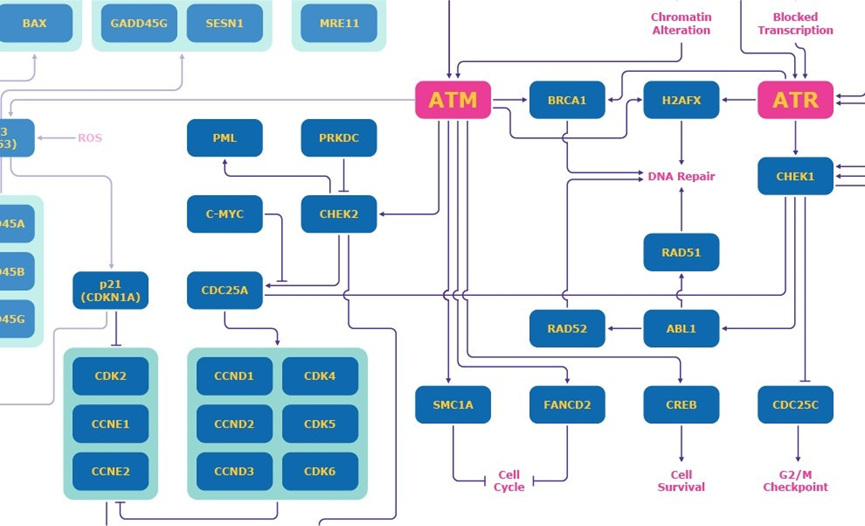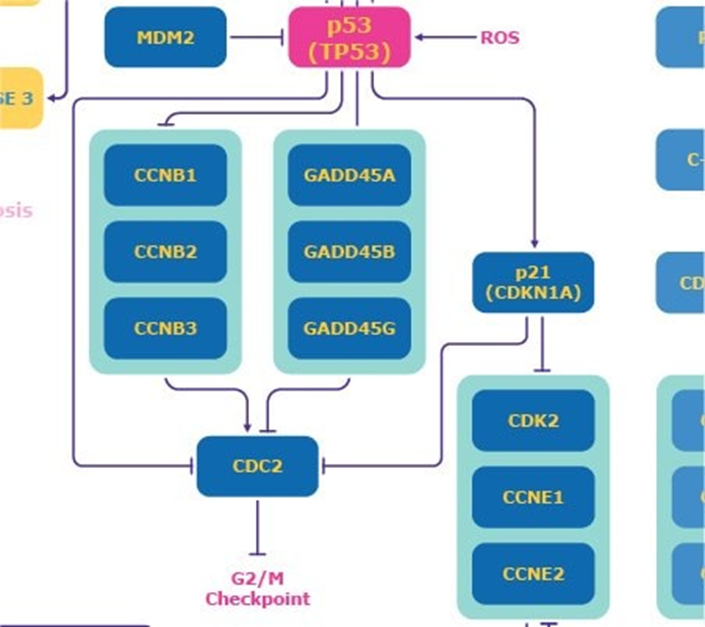DNA Damage Response Pathway
Overview: Signaling and Targets
Targeting the DNA damage response pathway is important in research on cancer, cell signaling, neurological disease, and more. See how key targets of DNA damage, such as MDM2, p53, ATM, ATR, p21, CDK2/Cyclin E, GADD45, and more interact to regulate the DNA damage checkpoints below.

WHAT IS THE DNA DAMAGE RESPONSE PATHWAY?
The DNA damage response (DDR) pathway is initiated by cells to repair DNA when they detect DNA damage. There are different types of DNA damage including endogenous DNA damage and exogenous DNA damage. Examples of each include:
• Endogenous: replication errors, base deamination, oxidative damage by reactive oxygen species, etc.
• Exogenous: ionizing radiation, ultraviolet radiation, chemicals/toxins, environmental stress, etc.
The effects of DNA damage include mutations, apoptosis, and more. This damage can lead to dysregulated cell function and eventually cancer, neurological disease, and premature aging.
KEY TARGETS OF DNA DAMAGE CHECKPOINTS
There are cell cycle checkpoints that can be activated in response to DNA damage. These DNA damage checkpoints include:
• G1 checkpoint (between G1 and S phases)
• Intra-S checkpoint (in S phase)
• G2 checkpoint (between the G2 and M phases)
Key proteins associated with these checkpoints in the DDR pathway can be used as targets to gain a deeper understanding of this process and find potential therapeutics. These key targets of DNA damage checkpoints include:
• MDM2 (Mouse double minute 2)
• p53 (Tumor protein p53)
• ATM (Ataxia-telangiectasia mutated)
• ATR (Ataxia–telangiectasia and Rad3-related)
• p21 (Cyclin-dependent kinase inhibitor)
• CDK2/Cyclin E (Cyclin-dependent kinase 2)
DDR targets play a key role in mechanisms involved in the G1/S, S, and G2/M checkpoints. 3 Specifically, the roles of ATM, ATR, and p53 are popular in research on DNA damage response.
ATM AND ATR
ATM is important in various aspects of DNA damage response (Figure 1). The ATM kinase is activated by DNA double strand breaks which lead to chromatin alteration and trigger the G1 checkpoint through activation of checkpoint kinase 2 (CHEK2). CHEK2 then inhibits CDC25A which prevents it from inhibiting CDK2/Cyclin E and ultimately prevents the cell from moving to S phase.
The ATR kinase is activated by DNA double strand breaks and blocked transcription and activates the intra-S checkpoint. ATR activates checkpoint kinase 1 (CHEK1) which induces CDC25A degradation and stops the cell from continuing through S phase. The ATR kinase and CHEK1 also activate the G2 checkpoint. CHEK1 inhibits CDC25C which prevents the cell from moving to the M phase.

Figure:.The DNA damage response pathway focusing on ATM and ATR mechanisms.
The G1 checkpoint is also dependent on p53. The tumor suppressor protein p53 is known as the “guardian of the genome” and is normally found at low levels due to negative feedback loop interactions with MDM2, an ubiquitin ligase. In response to DNA damage, ATM can induce phosphorylation of p53, which reduces the effect of MDM2 and activates p53. Reactive oxygen species (ROS) also activate p53. This induces p21 (Figure 2) which inhibits CDK2/Cyclin E and prevents movement into the S phase.
Activated p53 also upregulates the GADD45 complex which has products that influence cell cycle arrest and apoptosis and prevents progression into the S phase. It can also initiate DNA repair. The GADD45 complex can also inhibit CDC2 which results in G2/M phase arrest, preventing entry into mitosis at the G2 checkpoint.

Figure :The DNA damage response pathway













